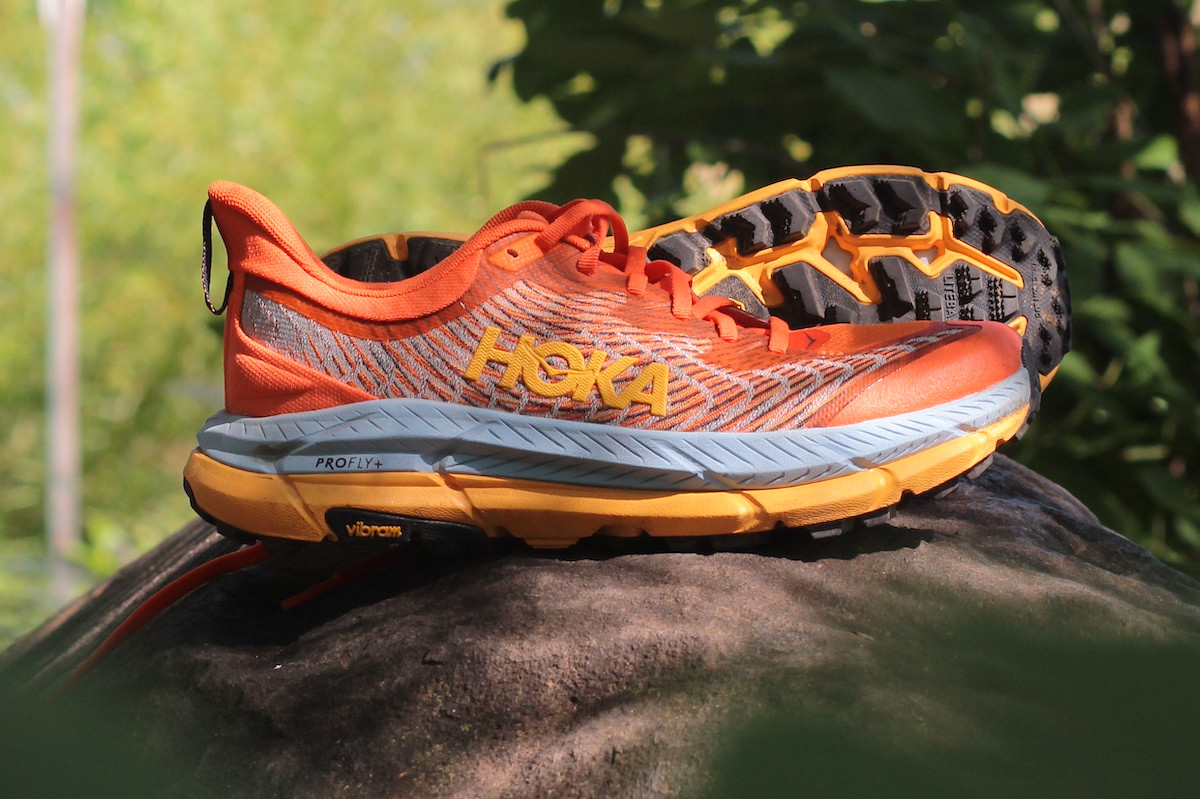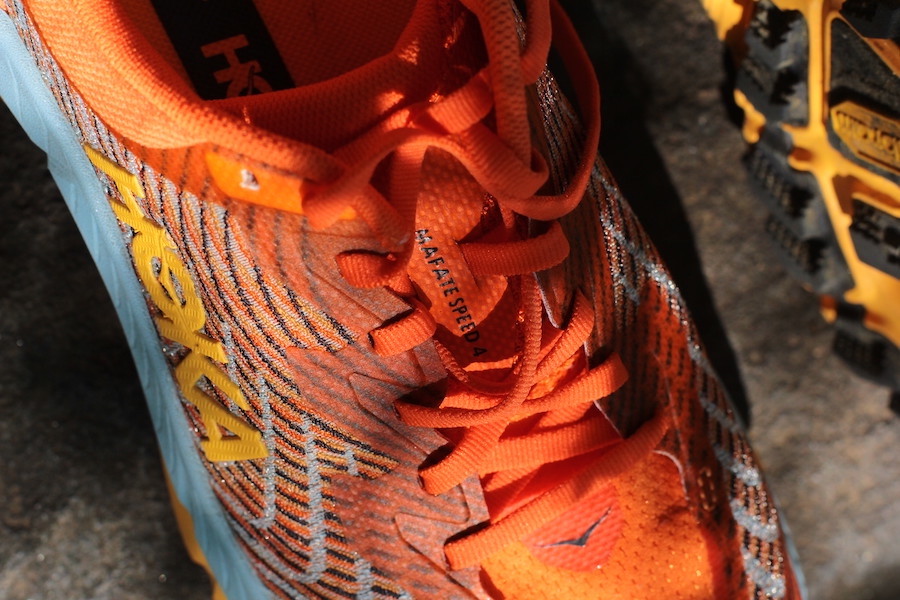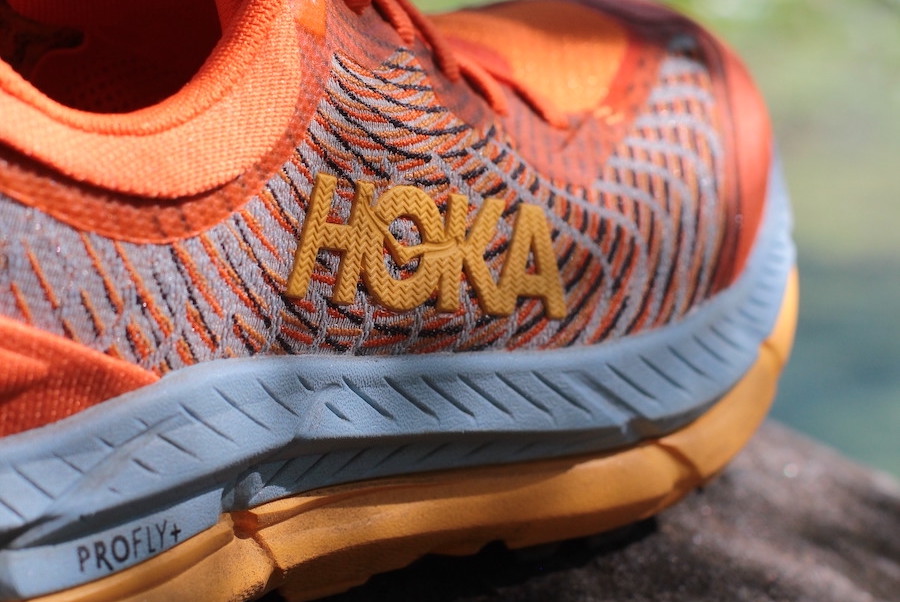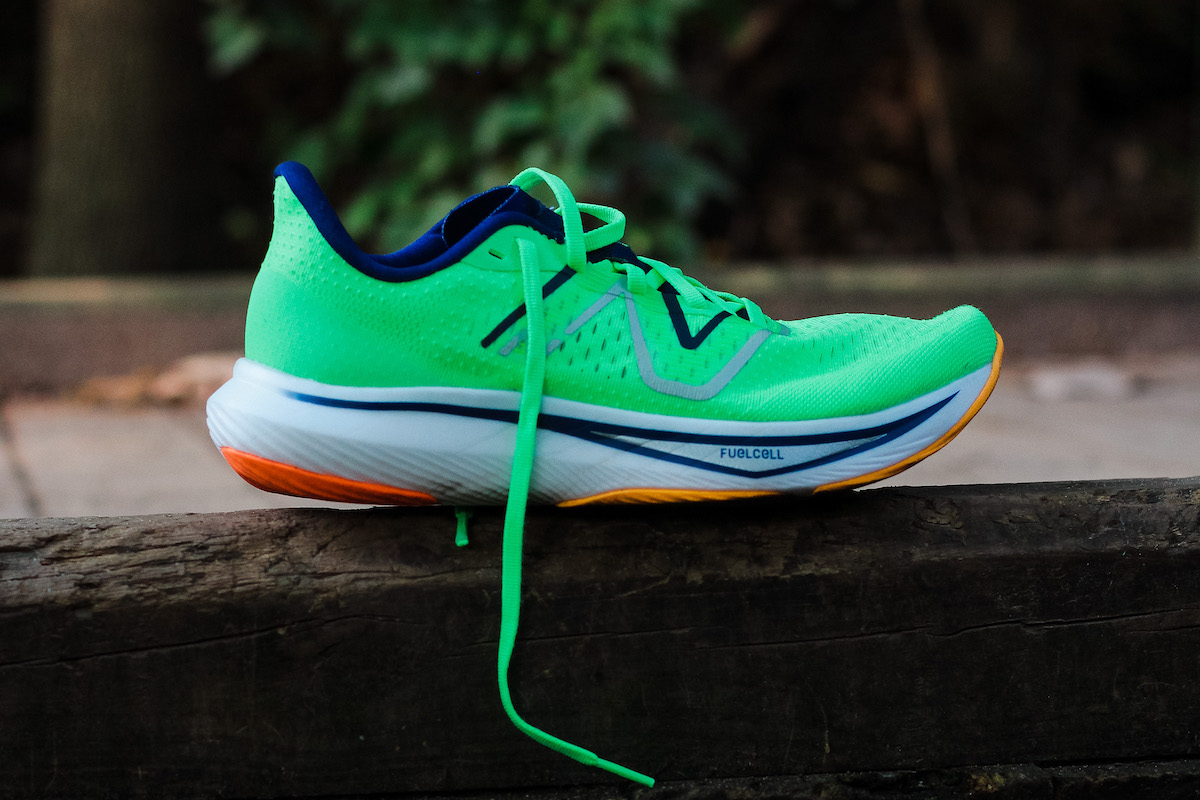
Weighs 10.4 oz. (294 g.) for a US M9 / 8.5 oz. (240 g.) for a US W7
Stacks on stacks on Profly stacks
Vibram Litebase never lets us down (and at this price, it better not)
Available now for $185 (yes, you read that right)
TAYLOR: I’m sitting here listening to the episode of our episode of The Drop podcast with Tony Post, founder of Topo Athletic. As I do, I can’t help but think about the vast assortment of running shoes in which his mark on the industry is somewhat ingrained, whether directly or indirectly. His touch finds a way into the minimalist and the megalodon, and each stack has its place. (If you’re not familiar with Tony Post, he was behind Vibram during the minimalist running boom, which precipitated the pendulum reaction of the maximalist shoe movement, i.e. Hoka).
If you dig into the running shoe archives of the last decade to find the max-cushion OGs, you’ll quickly find the Hoka Mafate. It’s the shoe that brought high stacks of foam to a trail market dominated by minimalism. The approach made it a fast favorite for all of us who wanted more beneath our feet. That Hoka somehow found a way to keep its foam lightweight and mix in a rockered midsole for a smooth stride made the shoe revolutionary. To say it was a shoe ahead of its time would be an understatement. The original Mafate taught us that yes, you really could do more with more — not less.
Since its inception, the Mafate Speed has undergone some incremental tweaks, and here we are with version four. Unfortunately, last year’s Mafate Speed 3 was a miss for us, but not for lack of trying. It had the cushion and protection, but it wasn’t cleaned up enough for anything more than easy cruising.
This year, however, changes are afoot. The Mafate Speed got a reboot as big as the Speedgoat, almost to the point of being a brand-new shoe. I know, a scary thought when you reminisce on the original. We’re talking a new upper, a Tecton-esque midsole, a revamped outsole, and more. Somehow more.
The changes reflect well on the spec sheet, but performance in the mountains is the real teller of tales. Max-cushioned trail runners are no longer a niche category, with the Brooks Caldera 6, Nike ZoomX Zegama, and Altra Mont Blanc entering the fray.
Now the question is whether or not Hoka can get back on its high horse with the original high horse.
MICHAEL: Onions, the Taco Bell five-layer burrito, Shrek, the Hoka Mafate Speed 4 — what do these great things all have in common? Layers. Each one has a slab of goodness (or greenness) stacked on top of the next.
Over the last year or so, Hoka has been slowly embracing layers of supercritical foam across its range of footwear, even if it’s not in a hurry. There seems to be a level of reservation, though, as there’s only one Hoka model with a fully supercritical midsole. Outside of the Carbon X 3, the brand can’t seem to quit its classic EVA and still adds a rubberized bottom layer when it wants some extra stack. The Hoka Mafate Speed 4 has one of those layers, but this time, Hoka seems to have it right.
Before this year, you’d be forgiven for mixing up the Speedgoat and the Mafate. They were both max-stack, trail-ready beasts. Now, there’s a well-defined divide. The Speedgoat 5 will still shine as the trail king, but the Mafate Speed 4 is poised for a leap — not just in price.
Let’s see how Hoka separates the sheep from the (Speed)goats.

TAYLOR: I’m no stranger to the Mafate Speed family. My love for the Evo Mafate 2 grew as I crammed more and more miles into it, yet I learned to loathe the Mafate Speed 3 just as quickly. Between the two, I wasn’t sure how I’d feel about another revamp. Now, after a mixed bag of miles in the shoe, there’s no doubt that Hoka is back on track.
As Hoka started seeding samples for its latest trail ripper, I couldn’t help but drool over the colorways. From a tropical punch bowl to well-accented forest green, the colorists were going wild. One appeared after another until, finally, a box arrived at my door. Lo and behold, it was the special UTMB colorway. I didn’t care how it performed, the looks alone were enough to make me smile. Rest assured, the performance kept me smiling.
Jacquard is a fun word to say, and it’s just as comfortable on foot. Better yet, the woven material is going to stand up to mile after mile on the trail. Hoka added a few light overlays through the lacing chain, toe bumper, and heel for subtle reinforcements, and I like its chances against my upcoming training block.
The overall shape of the Mafate Speed 4 has been altered a bit, and it now slides right between the Tecton X and Speedgoat. It takes a few properties from both and a sprinkle or two from the Evo Mafate.
Honestly, the change is more than welcome, as I found the Mafate Speed 3 far too roomy through the foot. Version four is much tighter throughout and feels very comfortable on foot. It’s secure, too, perhaps more than the Speedgoat 5, thanks to the jacquard mesh upper. The Mafate Speed 4 adopts a modestly padded semi-gusseted tongue, a nicely padded ankle, and a toebox pulled from other Hoka classics. It’s a bit roomier than the one in the Speedgoat 5, and the vamp allows for some natural toe splay.
I had no trouble with movement on steep, technical terrain, which was a pleasant surprise. Even if nothing else had changed, the updated upper would be worth it. More has changed, though, so let’s keep on truckin’.
The Mafate Speed 4 shares a lot with its Tecton X sibling regarding the underfoot experience. First, the midsole geometry (33mm heel, 29mm toe, 4mm drop) is almost identical, suggesting that the two will be stellar training companions. Also, the shared double layer of Profly+ on top of Profly gives you some of the best of both worlds. The Mafate Speed 4 skips the carbon plate, which makes it feel more cushioned and sustainable for long hauls.
I enjoyed the soft, bouncy layer of Profly+ just underfoot, and it sits on a firmer, more durable slab of Profly. The two trade off each other nicely, and the rockered shape brings it together. There’s just enough protection, response, and comfort to tackle a wide range of terrain. Don’t forget the wider-than-average footprint that lends a little bit of natural stability.
At the very bottom, a layer of Vibram Litebase adds to an already stellar package. It’s lighter and more focused on all-around performance than the rough and tumble Megagrip would be. Litebase checks the boxes on various terrain and weather conditions, and it even feels built to last. Even the unique lug pattern feels at home on smooth and dicey sections.

MICHAEL: When I first freed the Hoka Mafate Speed 4 from its cardboard prison, I was stunned by the wildly different durometers of the foams. The uber-soft Profly+ and firm Profly made me anticipate a shoe that would feel somehow disjointed. I was wrong. Sure, the two foams are noticeably different, but I never found that one took away from the other. Rather, both provided a framework for the other to play off of. If Hoka had chosen one foam or the other, the Mafate Speed 4 would have turned out either too hard or too soft. Sorry, Goldilocks.
Usually, I’d be worried about stability in a shoe this tall, too. Once again, not the case. I felt secure and protected no matter how quickly I whipped around turns or bombed down descents. The bounce and speed of the Profly+ probably helped to counteract the weight of the shoe itself.
Hoka’s midsole isn’t the only thing that seems perfectly balanced, the upper is in on the fun as well. It lends comfort and security in equal measures, with durability in tow. I’ll give the supportive heel collar and prominent toe bumper some credit, too, as both ensure security without adding to the weight.
Brands sometimes go a little overboard on naming conventions, adding buzzwords to shoe titles for seemingly no reason (like when you were in high school and trying to pad your word count with adjectives in an essay). Initially, I forgot that the Mafate officially has speed in the name until I hit the trail. Then, the lightweight upper, aggressive traction, and oh-so-sweet bounce of the dual-layer midsole brought it right back to me.
Descents in the Mafate were especially fun, as I had no issues with fit, and the Vibram Litebase gripped everything. Just as it’s done for years and years, Vibram continues to impress. This was my first time trying out two relatively new Vibram technologies (Litebase and Traction Lug), and they’re no gimmicks. In the words of Robbe: “Megagrip? More like MegaRIP.”
Thankfully, Taylor touched on some of the other high points. Otherwise, I would probably be writing forever. Like the trails the shoe is made for, the price tag is steep, coming in at $185. However, from the first step, I found that the package exudes quality. Everything screams excellence, from top to bottom.
Shop Hoka Mafate Speed – Women

TAYLOR: Hoka’s trail department has been hitting it out of the park with this year’s updates. Each entry seems to find a laundry list of positives and pairs it with just a few minor quirks here and there. For the Mafate Speed 4, the quirks are especially minimal.
During my first few runs, I noticed some lateral rubbing on my pinky toes, which is odd because the toe box feels the same shape as the Speedgoat but a little roomier. It’s my only real issue with the upper, and it might just be because so few shoes have real break-in periods anymore. Thankfully, the rubbing dissipated after those runs. It’s not a unique problem to the Mafate Speed 4, and it’s likely just because the mesh is more abrasive than we’ve seen in others like the Speedgoat 5.
MICHAEL: I’m honestly having a tough time finding anything to put in this section. The only gripe I have with the shoe is that I think Hoka pared down the outsole a little too much. I would have liked a tad bit more coverage on the middle of the shoe, as I think it would help a lot with rock hopping through stream crossings and other trail paraphernalia. While it would mean an ever so slight increase in weight, the Mafate is an all-mountain shoe, after all. It would be nice to see Hoka give the shoe full outsole coverage and save the exposed EVA for characteristically lighter shoes like the Tecton X.
Another minor gripe is that I want to see lace keepers on more shoes. Altra is an obvious candidate with its mile-long laces, but it would also be nice to see Hoka get in on the game. It could be that I’m a little spoiled from the lace keeper on the Brooks Caldera 6, Saucony Peregrine 12, or the super slick BOA dials on the Speedland SL:HSV, but I just like the feeling of having laces neatly tucked away for technical trails.
Shop Hoka Mafate Speed – Women

TAYLOR: At the end of the day, I like to weigh what the company says about the shoe against what the shoe can do well. Hoka nailed this one. Take Mafate Speed 4 anywhere, and you’ll be fine with it. This is the people’s Hoka. Performance, comfort, and style all meet together and shake hands emphatically here.
This one will be for people who want a similar fit to the Speedgoat 5 or Evo Mafate 2 but need more structure up top and cushion below. Even though I might pick the Speedgoat for more technical terrain, the Mafate will be a good all-arounder. Again, this would also be a great training partner for those who love the Tecton X.
I want to leave no doubt that this could be a great option for just about anything. For what it’s worth, this would probably be my number one choice for big ultras. I love what the Brooks Caldera 6 provided in terms of protection and stability. However, the Mafate now offers a hefty portion of all that goodness in a much lighter package (11.2 oz. for a US M10.5).
MICHAEL: The most significant competition for Mafate Speed 4 almost certainly comes within Hoka. Before the launch of the Speed 4, runners who sought a more aggressive Speedgoat had to choose between a heavier, more expensive Mafate Speed 3 (with a midsole that hadn’t been updated in generations) and the Speedgoat 4. You could see where most people landed after looking at pretty much any start line.
Things have changed, though, with the Mafate Speed 4. While I don’t think many runners will be looking to shell out an extra $30 over the Speedgoat 5 for what is essentially a more aggressive outsole and some super foam, I still wouldn’t hesitate to recommend jumping to the Mafate. The dual density midsole gives the shoe some honestly unique characteristics that you have to feel to believe.
Maybe it’s a personal preference, but I can’t think of a much better shoe for technical ultra racing. From the perfect blend of cushioning and stability, the wonderfully aggressive Vibram outsole, and the lightweight, yet protective upper, Hoka has knocked it out of the park with this one.
While the shoe is marketed as an all-mountain shoe and is likely aimed at UTMB or Hardrock more than the Southeastern US, I would recommend this to any fellow east coast ultra trail racer looking for a shoe that is stable yet cushioned and perfect for that steep, rooty, muddy, and slick east coast terrain. This will be my shoe of choice for this year’s Mountain Mist 50K, in addition to some FKT attempts this fall.
You can pick up the Hoka Mafate Speed 4 for $185 at Running Warehouse (featuring free 2-day shipping and 90-day returns) by using the shop link below.
Shop Hoka Mafate Speed – Women

Want to learn more about how our review process works? Check out this guide.

Have something to say? Leave a Comment

Taylor Bodin is a trail and ultra runner living in Estes Park, Colo., with his wife and daughters. As the head of the Dirt Division at Believe in the Run, trail running is pretty much the only hobby he can manage right now and loves it. Every so often, he will pop off a race or FKT attempt because competition is pure and the original motivator for him getting into running anyway.
More from Taylor

I’ve experienced some pretty dramatic instability in these when running down rocky descents. Luckily it has been inconsequential, but it leaves me feeling hesitant. Part of the issue is the heel doesn’t lock in very well, similar to the Speedgoat 5.
Run lots of technical trails in Colorado, gave the SG5 a try but had to ditch it because the upper never felt super secure with the stretchy mesh and narrow lacing column. Also got some awful lace bite that became unbearable.. so happy to see a little more cushioned tongue on the M4. (I landed on Topo Ultraventure 2s for long runs and two races and have been pretty happy). Wondering if you could speak more to the fit and lockdown on the Mafate 4 vs. the SG5?
I just purchased my first pair of Mafate shoes after wearing Hoka Speedgoat 3 and 4 for years. I found the cushioning to be firm and dead. Still searching for a suitable Speedgoat replacement.